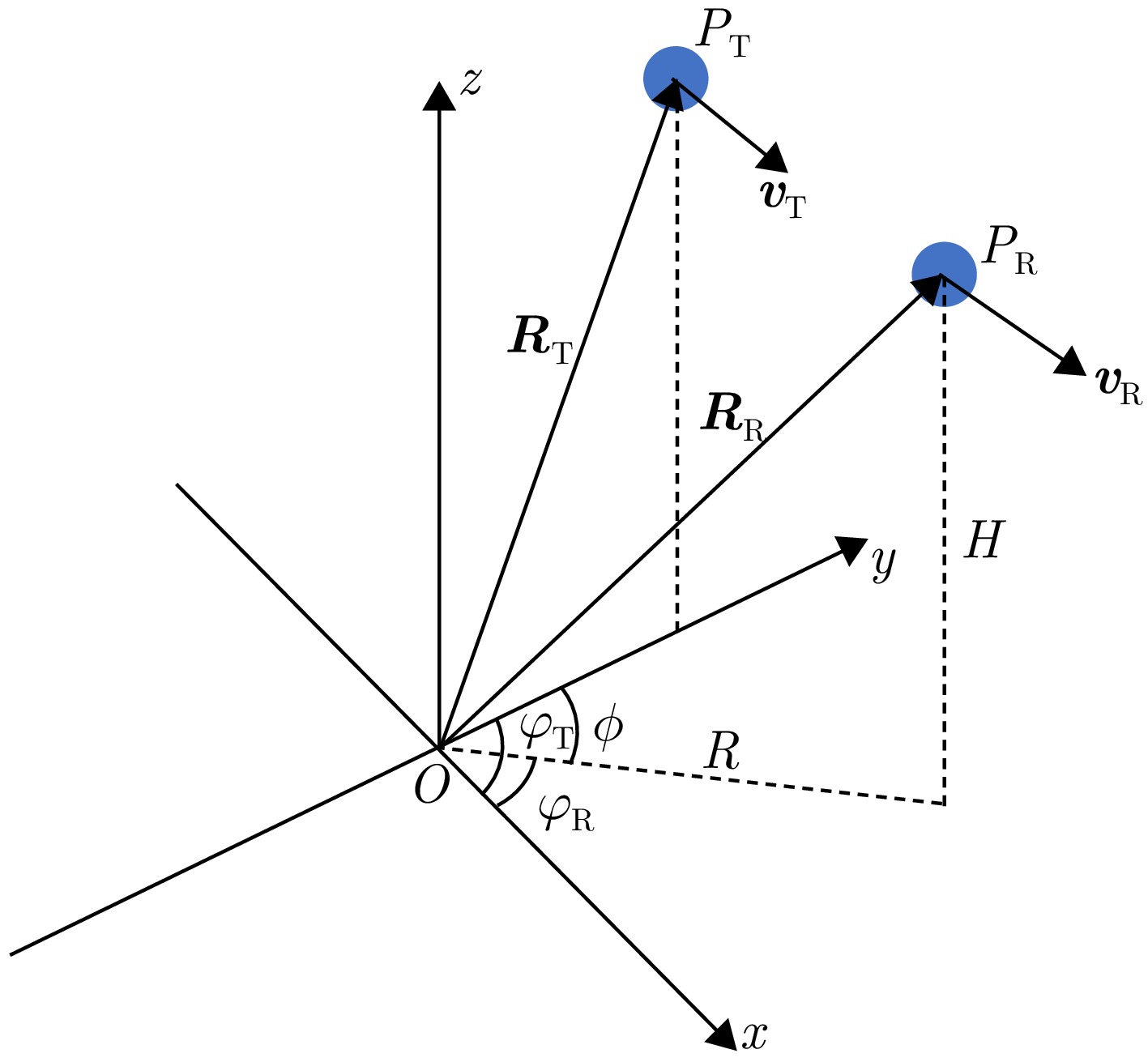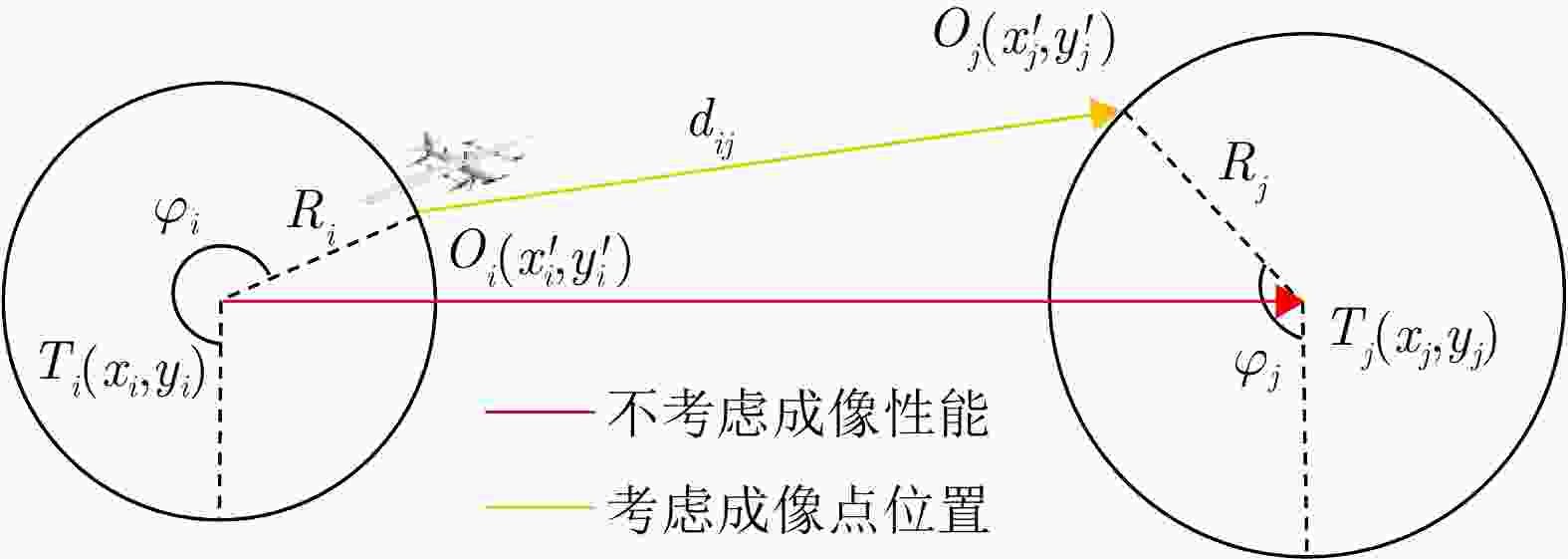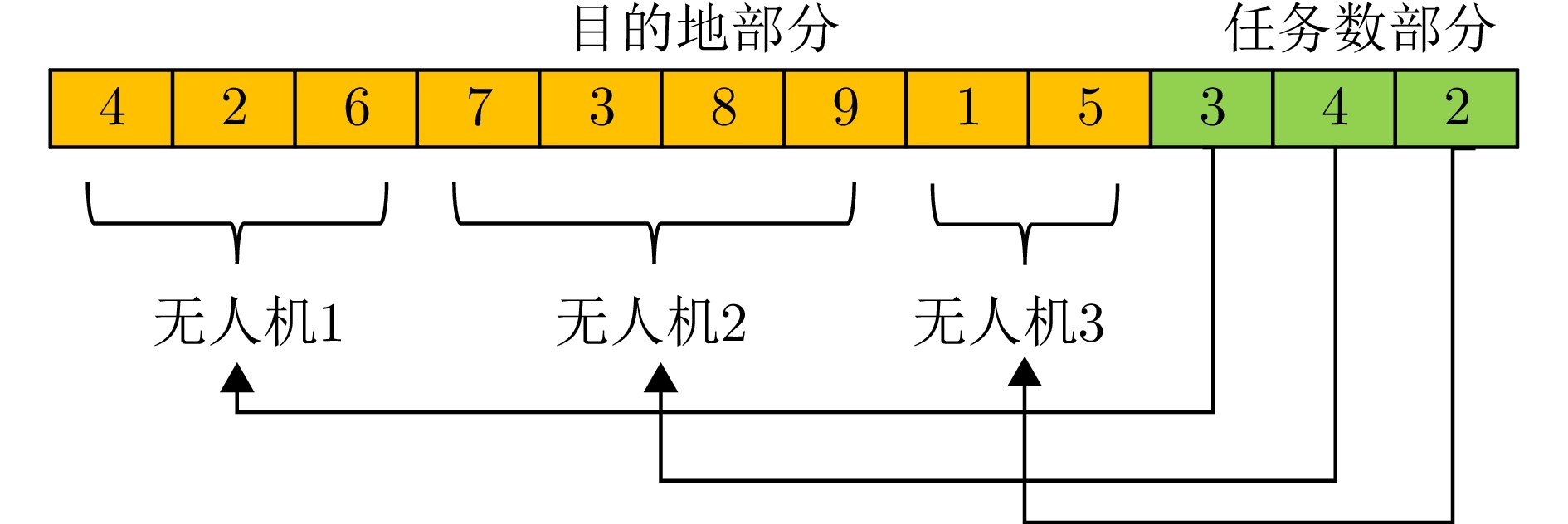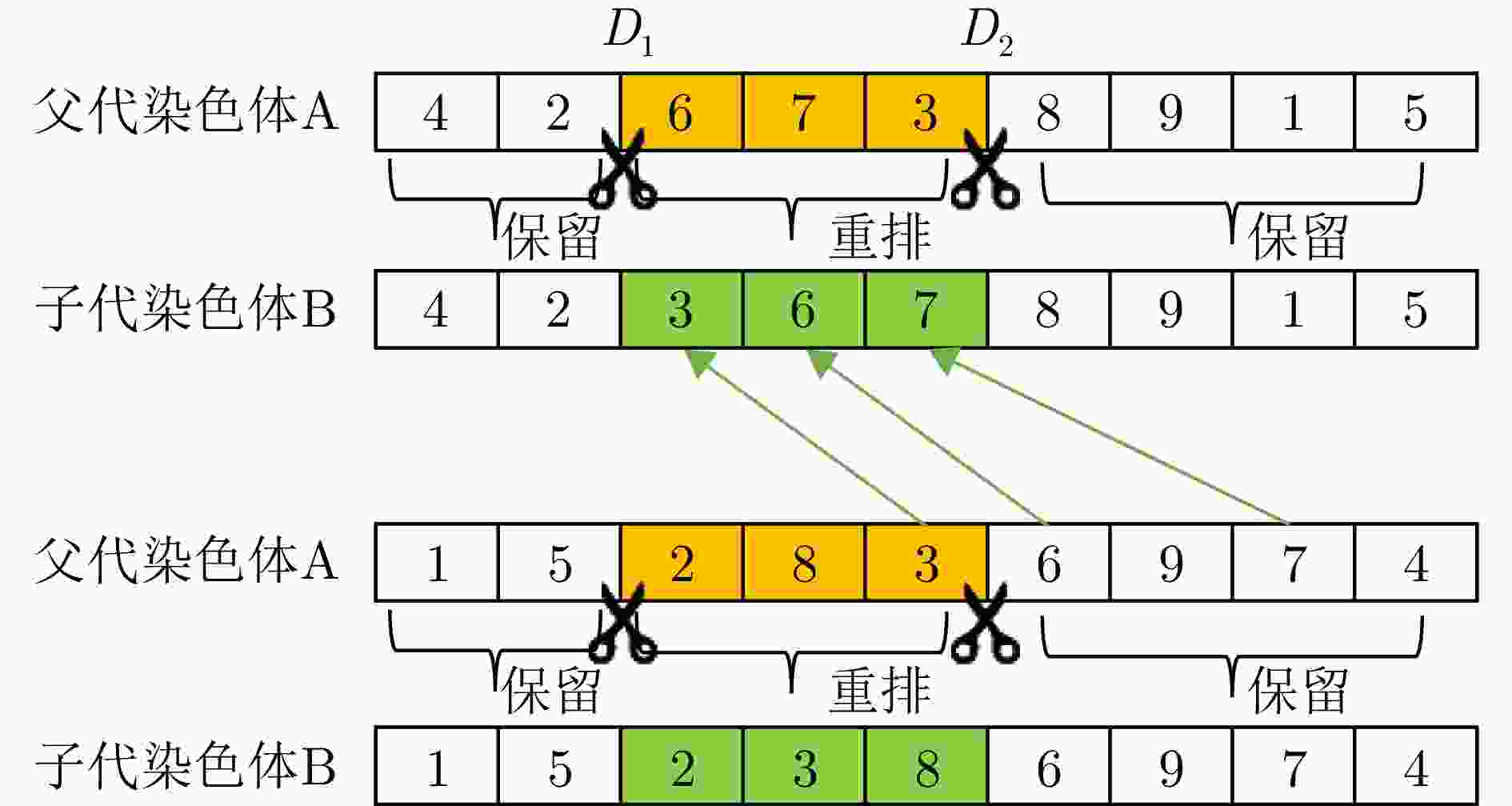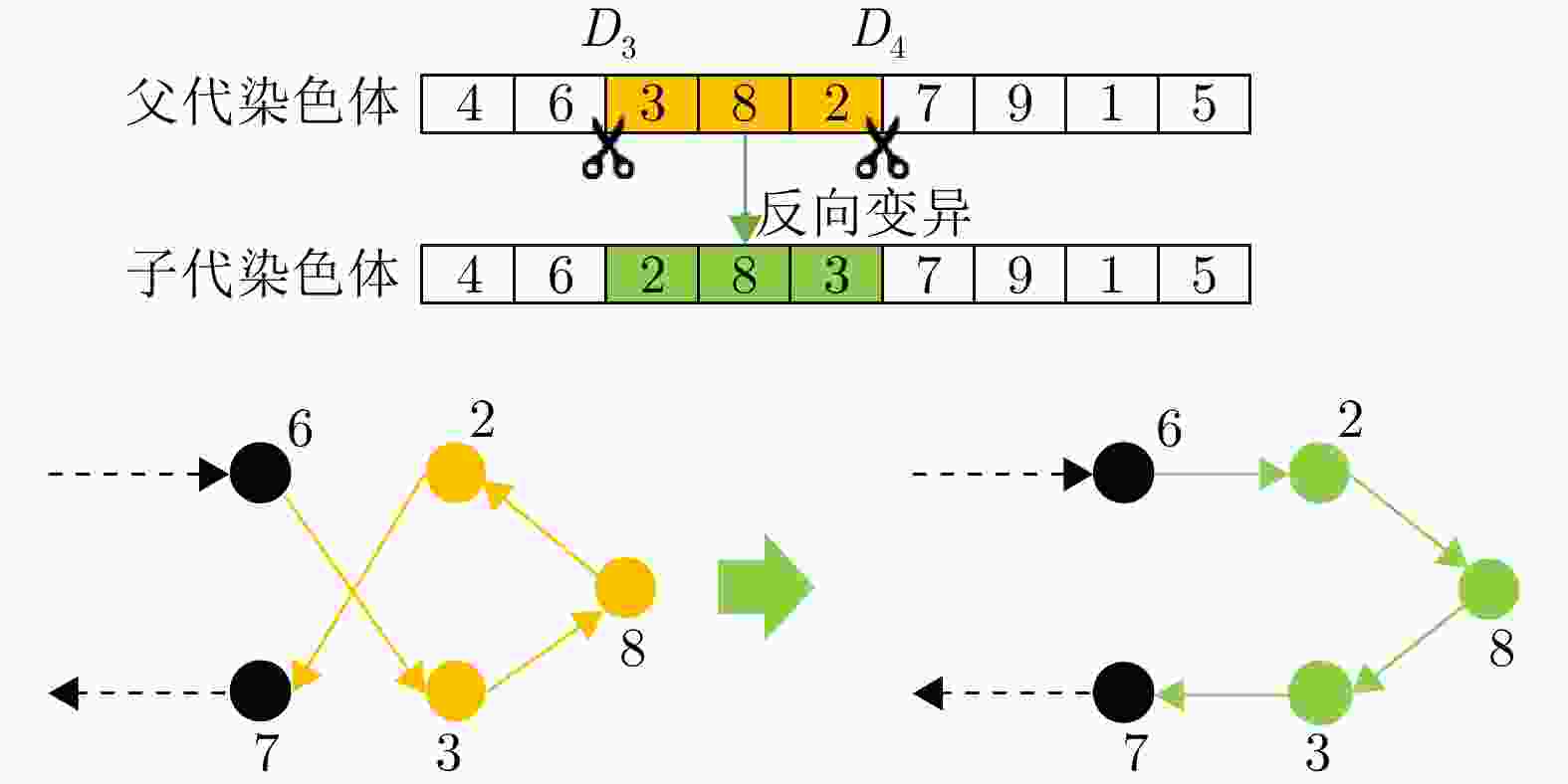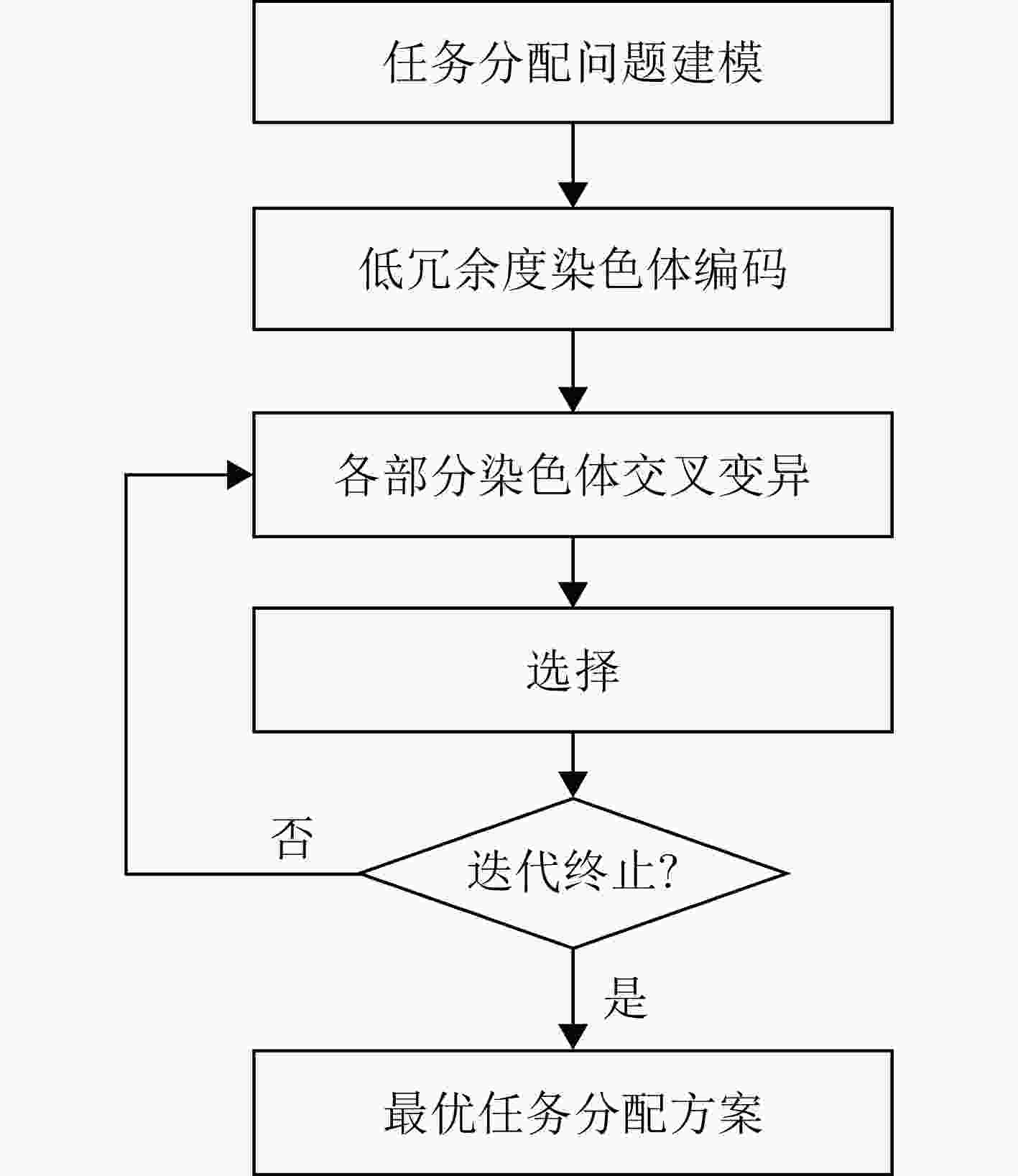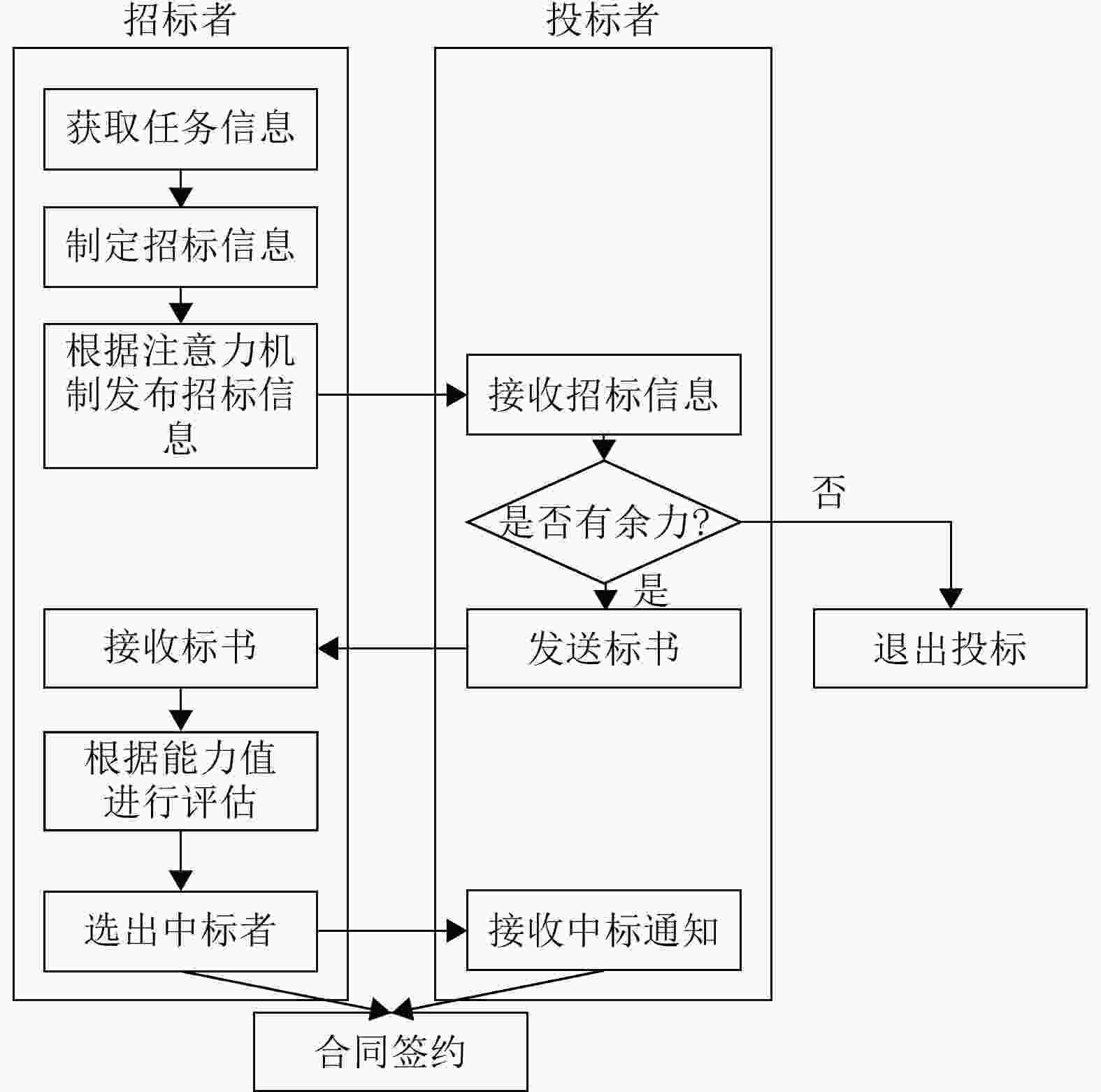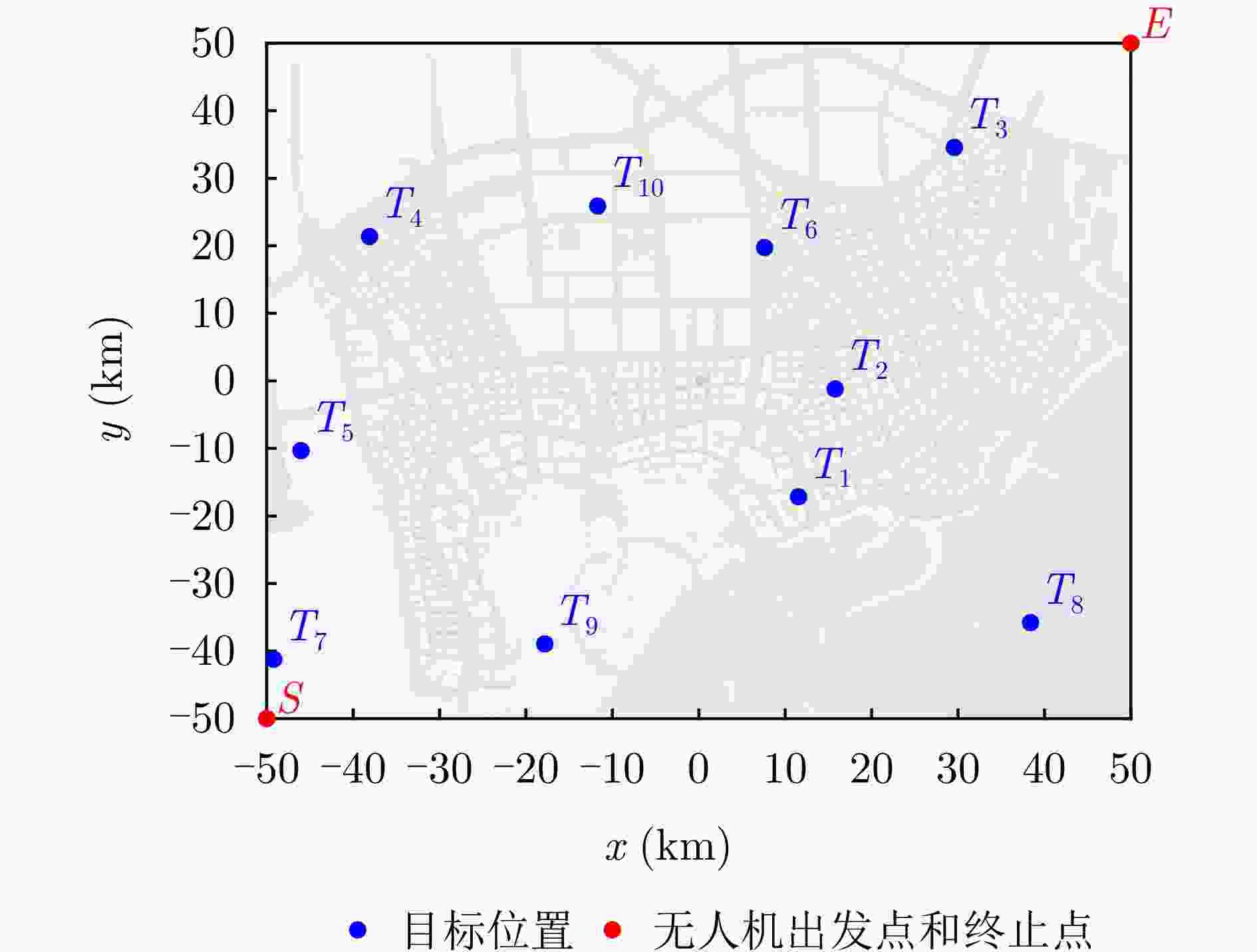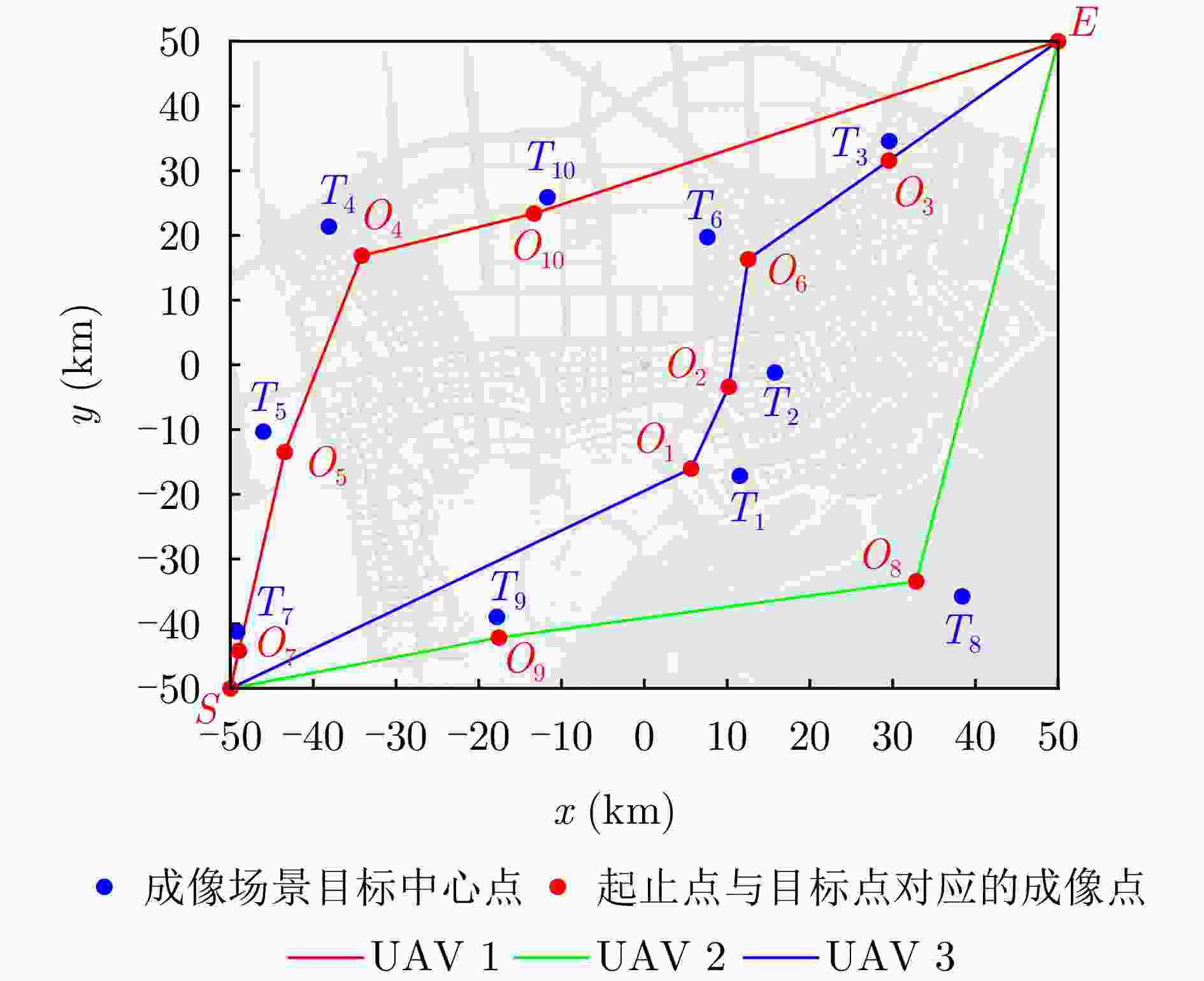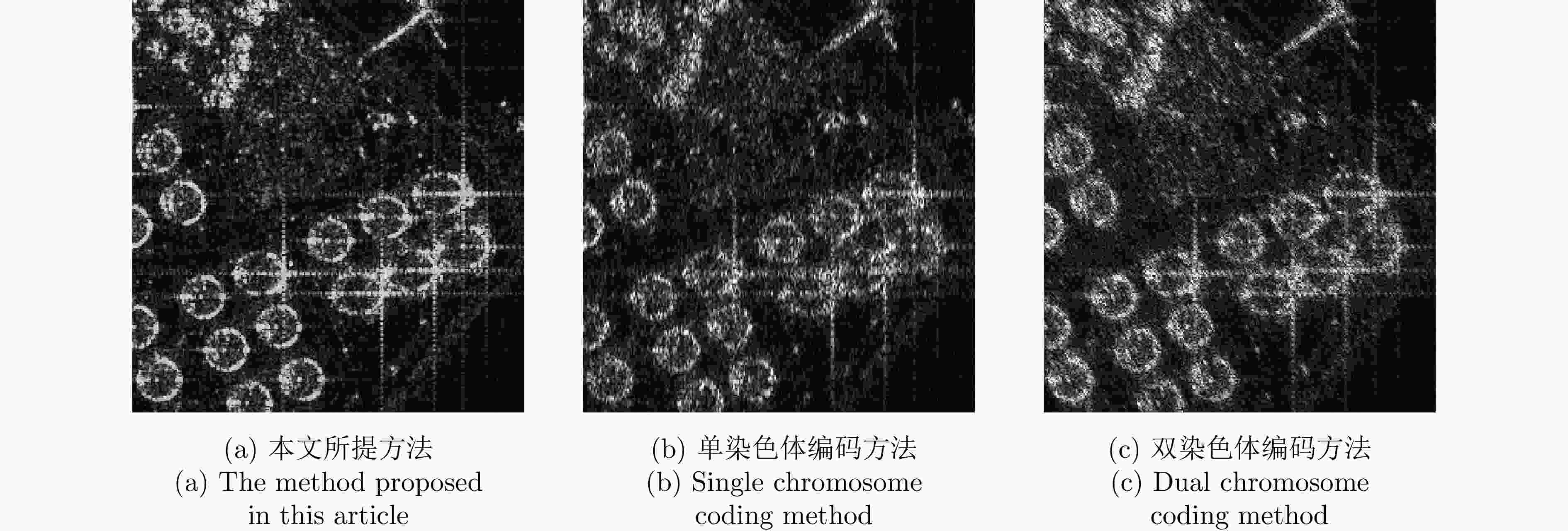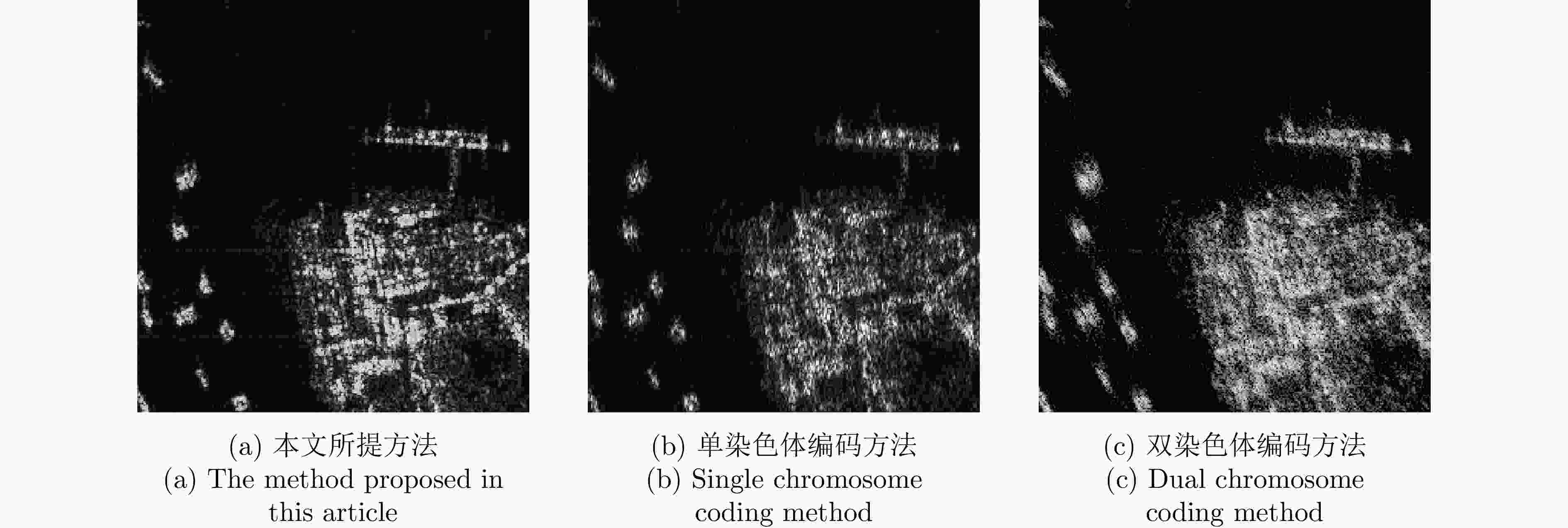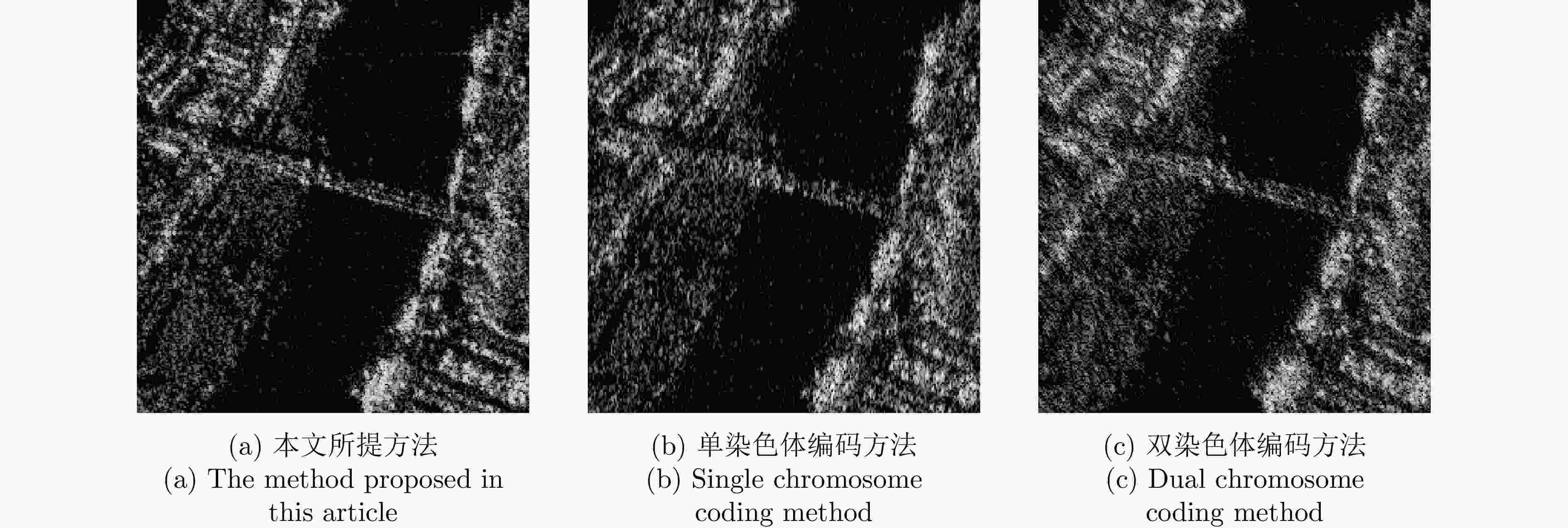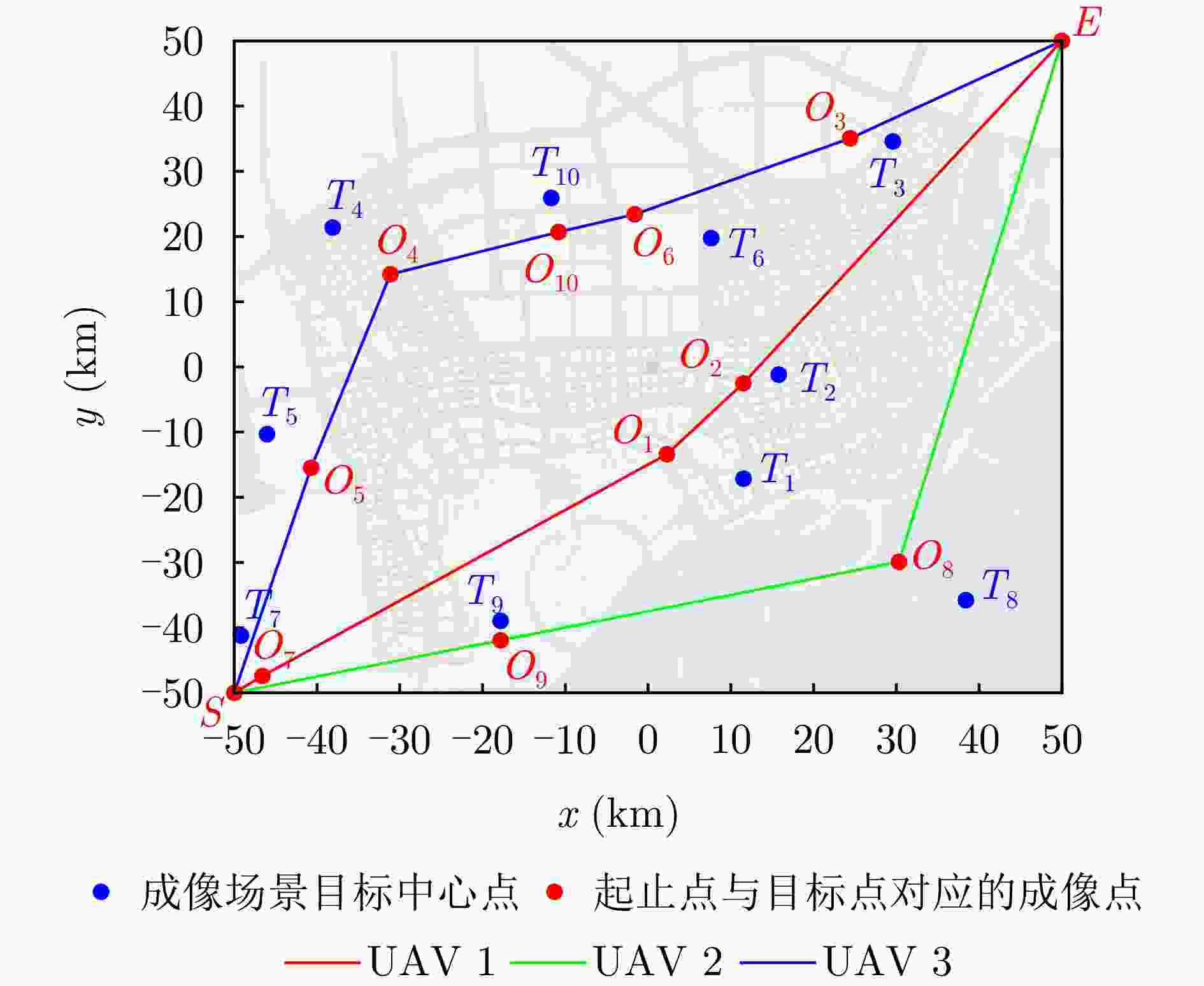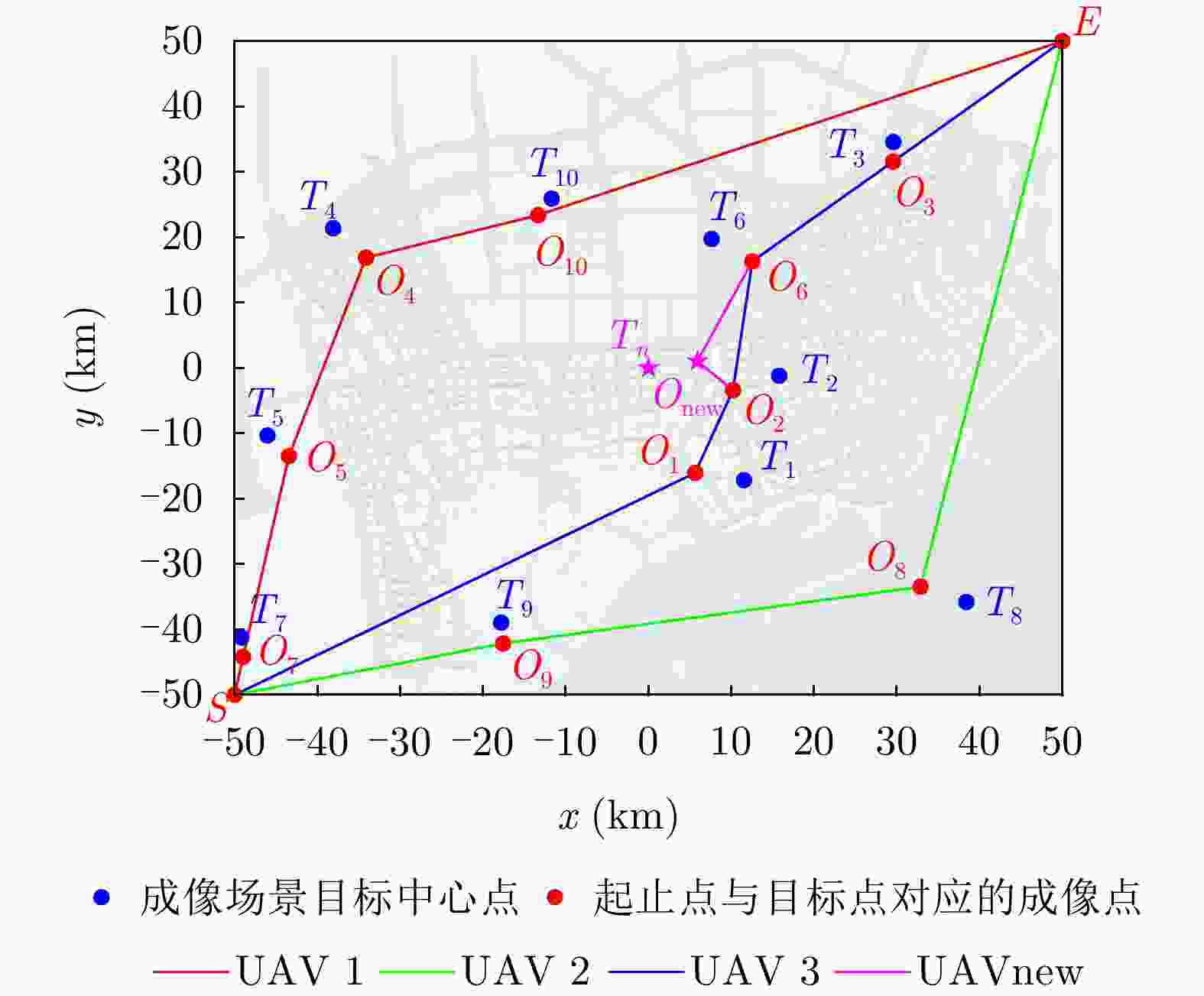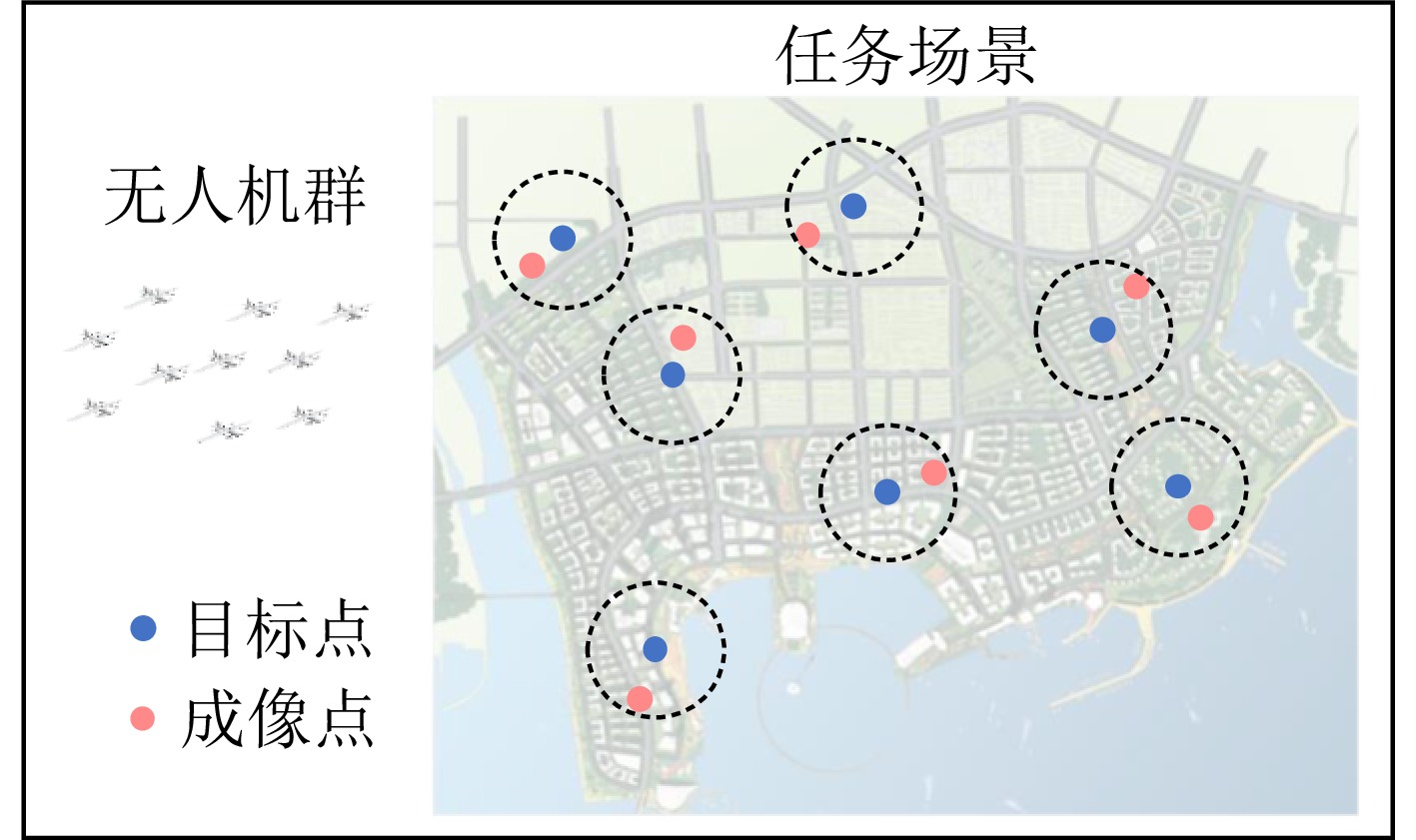A Task Allocation Method for Swarm UAV SAR Based on Low Redundancy Chromosome Encoding
-
摘要: 该文针对族群无人机SAR系统的任务分配问题,提出了一种基于低冗余度染色体编码的族群无人机SAR任务分配方法。该方法针对SAR成像任务的特有问题分析了成像性能与成像几何构型之间的内在联系,并据此建立了考虑成像性能的路径函数,将族群无人机SAR任务分配问题建模为广义均衡多旅行商问题;然后,采用冗余度较低的两部分染色体编码方式来表征任务分配方案,提高遗传算法的搜索效率和准确性。针对实际应用中可能发生的意外情况,该文还提出了一种融合了合同网算法和注意力机制的动态任务分配策略,该策略能够根据实际情况灵活调整任务分配方案,确保系统的鲁棒性。仿真实验验证了该文所提方法的有效性。Abstract: This paper addresses the task allocation problem in swarm Unmanned Aerial Vehicle (UAV) Synthetic Aperture Radar (SAR) systems and proposes a method based on low-redundancy chromosome encoding. It starts with a thorough analysis of the relationship between imaging performance and geometric configurations in SAR imaging tasks and accordingly constructs a path function that reflects imaging resolution performance. The task allocation problem is then formulated as a generalized, balanced multiple traveling salesman problem. To enhance the search efficiency and accuracy of the algorithm, a two-part chromosome encoding scheme with low redundancy is introduced. Additionally, considering possible unexpected situations and dynamic changes in practical applications, a dynamic task allocation strategy integrating a contract net protocol and attention mechanisms is proposed. This method can flexibly adjust task allocation strategies based on actual conditions, ensuring the robustness of the system. Simulation experiments validate the effectiveness of the proposed method.
-
Key words:
- Swarm UAV /
- Synthetic Aperture Radar (SAR) /
- Task allocation /
- Genetic algorithm /
- Chromosome encoding
-
表 1 系统参数
Table 1. System parameters
参数 符号 数值 波长(m) $\lambda $ 0.03 载波频率(GHz) ${f_{{\mathrm{c}}}}$ 10 带宽(MHz) ${B_{\rm r}}$ 300 合成孔径时间(s) ${T_{\rm a}}$ 2 发射站位置(km) ${P_{\rm T}}$ (0,– 35786 ,35786 )接收站高度(m) ${H_{\rm R}}$ 3000 接收站速度(m/s) ${v_{\rm R}}$ 50 表 2 任务执行情况
Table 2. Task execution status
无人机 飞行路径(km) 成像任务数 UAV 1 159.35 4 UAV 2 169.75 2 UAV 3 148.85 4 UAV 1—UAV 3总和 477.95 10 表 3 不同任务分配方法得到方案的性能指标
Table 3. Performance indicators of solutions obtained from different task allocation methods
方法 总飞行路径(km) 最大飞行路径(km) 总分辨面积(m2) 本文所提方法 477.94 169.75 13.69 单染色体编码法 493.38 192.69 18.95 双染色体编码法 576.01 258.31 21.89 粒子群算法 506.10 181.64 16.00 模拟退火算法 485.42 181.41 16.79 表 4 各任务分配方法所得成像结果的图像熵
Table 4. Image entropy of imaging results obtained by various task allocation methods
目标点 本文所提方法 单染色体编码法 双染色体编码法 T2 6.8240 6.1817 6.3874 T4 5.9558 5.7366 5.6229 T8 6.1061 5.8762 5.9497 表 5 成像任务需求
Table 5. Imaging task requirements
任务 分辨夹角需求 幅宽需求(m) NESZ需求(dB) 1 40°~140° 2000 –10 2 45°~135° 600 –20 3 40°~140° 1000 –20 4 60°~120° 2000 –15 5 60°~120° 1200 –18 6 45°~135° 1800 –15 7 80°~100° 1200 –18 8 40°~140° 2000 –15 9 80°~100° 600 –22 10 80°~100° 1000 –20 -
[1] 王岩飞, 刘畅, 詹学丽, 等. 无人机载合成孔径雷达系统技术与应用[J]. 雷达学报, 2016, 5(4): 333–349. doi: 10.12000/JR16089.WANG Yanfei, LIU Chang, ZHAN Xueli, et al. Technology and applications of UAV synthetic aperture radar system[J]. Journal of Radars, 2016, 5(4): 333–349. doi: 10.12000/JR16089. [2] 杨小鹏, 马忠杰, 钟世超, 等. 基于遗传算法的无人机载穿墙三维SAR航迹规划方法[J]. 雷达学报(中英文), 2024, 13(4): 731–746. doi: 10.12000/JR24068.YANG Xiaopeng, MA Zhongjie, ZHONG Shichao, et al. Trajectory planning method for UAV-through-the-wall 3D SAR based on a genetic algorithm[J]. Journal of Radars, 2024, 13(4): 731–746. doi: 10.12000/JR24068. [3] RUNKLE P, NGUYEN L H, MCCLELLAN J H, et al. Multi-aspect target detection for SAR imagery using hidden Markov models[J]. IEEE Transactions on Geoscience and Remote Sensing, 2001, 39(1): 46–55. doi: 10.1109/36.898664. [4] PAPSON S and NARAYANAN R M. Classification via the shadow region in SAR imagery[J]. IEEE Transactions on Aerospace and Electronic Systems, 2012, 48(2): 969–980. doi: 10.1109/TAES.2012.6178042. [5] ZHANG Haichao, NASRABADI N M, ZHANG Yanning, et al. Multi-view automatic target recognition using joint sparse representation[J]. IEEE Transactions on Aerospace and Electronic Systems, 2012, 48(3): 2481–2497. doi: 10.1109/TAES.2012.6237604. [6] SCHREIBER E, HEINZEL A, PEICHL M, et al. Advanced buried object detection by multichannel, UAV/drone carried synthetic aperture radar[C]. 2019 13th European Conference on Antennas and Propagation, Krakow, Poland, 2019: 1–5. [7] DING Manlai, DING Chibiao, TANG Li, et al. A W-band 3-D integrated mini-SAR system with high imaging resolution on UAV platform[J]. IEEE Access, 2020, 8: 113601–113609. doi: 10.1109/ACCESS.2020.3003273. [8] CHEN Ming, WANG Huibin, CHANG C Y, et al. SIDR: A swarm intelligence-based damage-resilient mechanism for UAV swarm networks[J]. IEEE Access, 2020, 8: 77089–77105. doi: 10.1109/ACCESS.2020.2989614. [9] ZHOU Yongkun, RAO Bin, and WANG Wei. UAV swarm intelligence: Recent advances and future trends[J]. IEEE Access, 2020, 8: 183856–183878. doi: 10.1109/ACCESS.2020.3028865. [10] WALTERSCHEID I and BRENNER A R. Multistatic and multi-aspect SAR data acquisition to improve image interpretation[C]. 2013 IEEE International Geoscience and Remote Sensing Symposium, Melbourne, Australia, 2013: 4194–4197. doi: 10.1109/IGARSS.2013.6723758. [11] PETERSON E H, FOTOPOULOS G, SCHMITT A, et al. Registration of multi-frequency SAR imagery using phase correlation methods[C]. 2011 IEEE International Geoscience and Remote Sensing Symposium, Vancouver, Canada, 2011: 3708–3711. doi: 10.1109/IGARSS.2011.6050030. [12] SUN Zhichao, WU Junjie, PEI Jifang, et al. Inclined geosynchronous spaceborne-airborne bistatic SAR: Performance analysis and mission design[J]. IEEE Transactions on Geoscience and Remote Sensing, 2016, 54(1): 343–357. doi: 10.1109/TGRS.2015.2457034. [13] REN Hang, SUN Zhichao, YANG Jianyu, et al. Swarm UAV SAR for 3-D imaging: System analysis and sensing matrix design[J]. IEEE Transactions on Geoscience and Remote Sensing, 2022, 60: 5238316. doi: 10.1109/TGRS.2022.3221775. [14] REN Hang, SUN Zhichao, YANG Jianyu, et al. A hybrid resolution enhancement framework for swarm UAV SAR based on cost-effective formation strategy[J]. IEEE Transactions on Geoscience and Remote Sensing, 2024, 62: 5200216. doi: 10.1109/TGRS.2023.3338247. [15] 毕文豪, 张梦琦, 高飞, 等. 无人机集群任务分配技术研究综述[J]. 系统工程与电子技术, 2024, 46(3): 922–934. doi: 10.12305/j.issn.1001-506X.2024.03.18.BI Wenhao, ZHANG Mengqi, GAO Fei, et al. Review on UAV swarm task allocation technology[J]. Systems Engineering and Electronics, 2024, 46(3): 922–934. doi: 10.12305/j.issn.1001-506X.2024.03.18. [16] 袁野, 杨剑, 刘辛雨, 等. 基于任务效用最大化的多雷达协同任务规划算法[J]. 雷达学报, 2023, 12(3): 550–562. doi: 10.12000/JR23013.YUAN Ye, YANG Jian, LIU Xinyu, et al. Multiradar collaborative task planning based on task utility maximization[J]. Journal of Radars, 2023, 12(3): 550–562. doi: 10.12000/JR23013. [17] 沈林成, 陈璟, 王楠. 飞行器任务规划技术综述[J]. 航空学报, 2014, 35(3): 593–606. doi: 10.7527/S1000-6893.2013.0500.SHEN Lincheng, CHEN Jing, and WANG Nan. Overview of air vehicle mission planning techniques[J]. Acta Aeronautica et Astronautica Sinica, 2014, 35(3): 593–606. doi: 10.7527/S1000-6893.2013.0500. [18] WANG Zhu, LIU Li, LONG Teng, et al. Multi-UAV reconnaissance task allocation for heterogeneous targets using an opposition-based genetic algorithm with double-chromosome encoding[J]. Chinese Journal of Aeronautics, 2018, 31(2): 339–350. doi: 10.1016/j.cja.2017.09.005. [19] JIA Zhenyue, YU Jianqiao, AI Xiaolin, et al. Cooperative multiple task assignment problem with stochastic velocities and time windows for heterogeneous unmanned aerial vehicles using a genetic algorithm[J]. Aerospace Science and Technology, 2018, 76: 112–125. doi: 10.1016/j.ast.2018.01.025. [20] XU Guangtong, LIU Li, LONG Teng, et al. Cooperative multiple task assignment considering precedence constraints using multi-chromosome encoded genetic algorithm[C]. 2018 AIAA Guidance, Navigation, and Control Conference, Kissimmee, Florida, 2018. doi: 10.2514/6.2018-1859. [21] 林君灿, 贾高伟, 侯中喜. 异构UAV编队反雷达作战中任务分配方法[J]. 系统工程与电子技术, 2018, 40(9): 1986–1992. doi: 10.3969/j.issn.1001-506X.2018.09.14.LIN Juncan, JIA Gaowei, and HOU Zhongxi. Research on task assignment of heterogeneous UAV formation in the anti-radar combat[J]. Systems Engineering and Electronics, 2018, 40(9): 1986–1992. doi: 10.3969/j.issn.1001-506X.2018.09.14. [22] 杜继永, 张凤鸣, 杨骥, 等. 多UCAV协同任务分配模型及粒子群算法求解[J]. 控制与决策, 2012, 27(11): 1751–1755. doi: 10.13195/j.cd.2012.11.154.dujy.005.DU Jiyong, ZHANG Fengming, YANG Ji, et al. Cooperative task assignment for multiple UCAV using particle swarm optimization[J]. Control and Decision, 2012, 27(11): 1751–1755. doi: 10.13195/j.cd.2012.11.154.dujy.005. [23] LIM W H and ISA N A. Particle swarm optimization with dual-level task allocation[J]. Engineering Applications of Artificial Intelligence, 2015, 38: 88–110. doi: 10.1016/j.engappai.2014.10.022. [24] 张大琳, 易伟, 孔令讲. 面向组网雷达干扰任务的多干扰机资源联合优化分配方法[J]. 雷达学报, 2021, 10(4): 595–606. doi: 10.12000/JR21071.ZHANG Dalin, YI Wei, and KONG Lingjiang. Optimal joint allocation of multijammer resources for jamming netted radar system[J]. Journal of Radars, 2021, 10(4): 595–606. doi: 10.12000/JR21071. [25] CONG Rui, QI Juntong, WU Chong, et al. Multi-UAVs cooperative detection based on improved NSGA-II algorithm[C]. 2020 39th Chinese Control Conference, Shenyang, China, 2020: 1524–1529. doi: 10.23919/CCC50068.2020.9188354. [26] ZOU Dexuan, LIU Haikuan, GAO Liqun, et al. An improved differential evolution algorithm for the task assignment problem[J]. Engineering Applications of Artificial Intelligence, 2011, 24(4): 616–624. doi: 10.1016/j.engappai.2010.12.002. [27] HUO Lisu, ZHU Jianghan, WU Guohua, et al. A novel simulated annealing based strategy for balanced UAV task assignment and path planning[J]. Sensors, 2020, 20(17): 4769. doi: 10.3390/s20174769. [28] 杨玮, 李然, 张堃. 基于变邻域模拟退火算法的多自动导引车任务分配优化[J]. 计算机应用, 2021, 41(10): 3056–3062. doi: 10.11772/j.issn.1001-9081.2020121919.YANG Wei, LI Ran, and ZHANG Kun. Task allocation optimization for automated guided vehicles based on variable neighborhood simulated annealing algorithm[J]. Journal of Computer Applications, 2021, 41(10): 3056–3062. doi: 10.11772/j.issn.1001-9081.2020121919. [29] SUN Zhichao, REN Hang, SUN Huarui, et al. Terminal trajectory planning for synthetic aperture radar imaging guidance based on chronological iterative search framework[J]. IEEE Transactions on Cybernetics, 2024, 54(5): 3065–3078. doi: 10.1109/TCYB.2022.3231974. [30] SUN Zhichao, WU Junjie, YEN G G, et al. Performance analysis and system implementation for energy-efficient passive UAV radar imaging system[J]. IEEE Transactions on Vehicular Technology, 2023, 72(8): 9938–9955. doi: 10.1109/TVT.2023.3260876. [31] SUN Zhichao, YEN G G, WU Junjie, et al. Mission planning for energy-efficient passive UAV radar imaging system based on substage division collaborative search[J]. IEEE Transactions on Cybernetics, 2023, 53(1): 275–288. doi: 10.1109/TCYB.2021.3090662. [32] HU Cheng, CHEN Zhiyang, DONG Xichao, et al. Multistatic geosynchronous SAR resolution analysis and grating lobe suppression based on array spatial ambiguity function[J]. IEEE Transactions on Geoscience and Remote Sensing, 2020, 58(9): 6020–6038. doi: 10.1109/TGRS.2020.2969573. [33] 王朝辉, 徐瑞, 李朝玉, 等. 加权负载均衡合同网大规模星座任务分配方法[J]. 航天控制, 2023, 41(4): 59–66. doi: 10.16804/j.cnki.issn1006-3242.2023.04.010.WANG Zhaohui, XU Rui, LI Zhaoyu, et al. Large-scale constellation task allocation method through weighted load balancing contract network[J]. Aerospace Control, 2023, 41(4): 59–66. doi: 10.16804/j.cnki.issn1006-3242.2023.04.010. [34] 陈杰, 黄志祥, 夏润繁, 等. 大规模多类SAR目标检测数据集-1.0[J/OL]. 雷达学报, 2022. https://radars.ac.cn/web/data/getData?dataType=MSAR.CHEN Jie, HUANG Zhixiang, XIA Runfan, et al. Large-scale multi-class SAR image target detection dataset-1.0[J/OL]. Journal of Radars, 2022. https://radars.ac.cn/web/data/getData?dataType=MSAR. -



 作者中心
作者中心 专家审稿
专家审稿 责编办公
责编办公 编辑办公
编辑办公
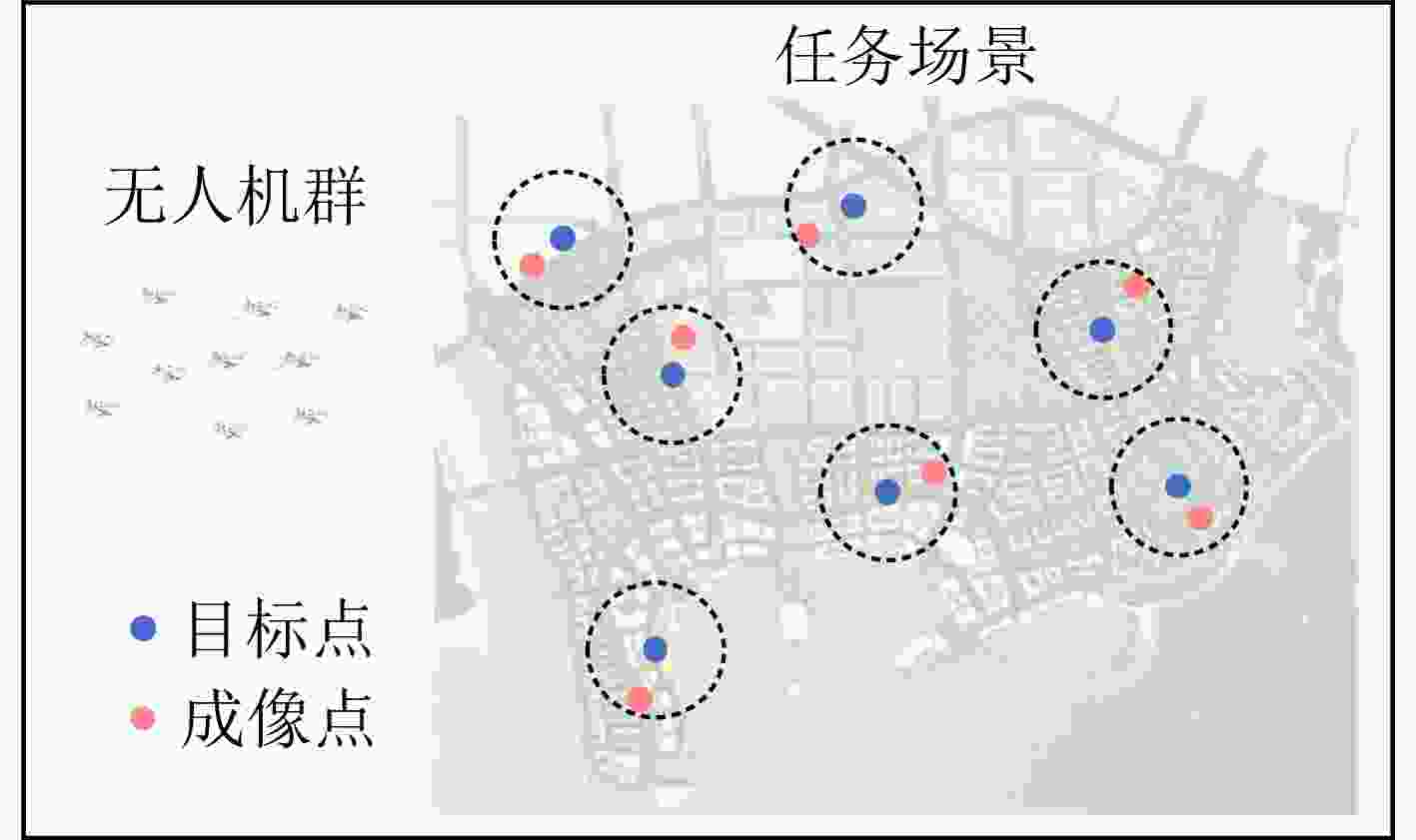
 下载:
下载:
